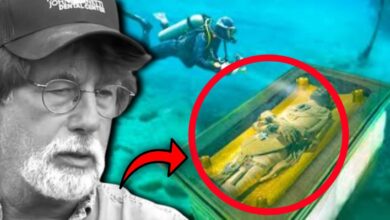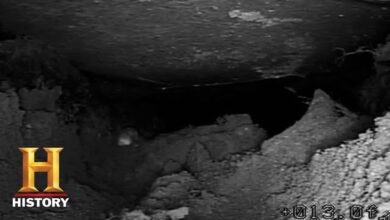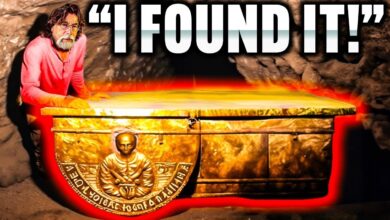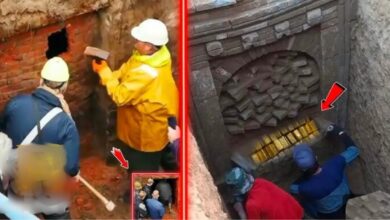Buried Riches and Hidden Agendas: 3 Leading Theories | The Curse of Oak Island
Buried Riches and Hidden Agendas: 3 Leading Theories | The Curse of Oak Island

MATTY BLAKE: A stone road dating
back five centuries or more.
EXPERT 1: This is a type
of road that was built by the Portuguese in the 1500s.
Wow. What is this? It kind of looks like parchment.
MATTY BLAKE: Ancient documents,
possibly linked to the world’s most famous playwright.
EXPERT 2: There is a
coded map in Shakespeare leading you to Oak Island.
MATTY BLAKE: A centuries-old
construction site– So what is this thing? A British pine tar kiln.
MATTY BLAKE: –linked
to one of the most powerful militaries in history. It could have been
used for the construction of the Money Pit.
Wow.
MATTY BLAKE: And a
sacred artifact– Holy shamoly, all
right, that’s a cross.
MATTY BLAKE: –potentially
belonging to a medieval order of Christian monks.
The season 10 premiere of
“The Curse of Oak Island” is just a few short weeks away. That means brothers
Rick and Marty Lagina, along with their
team, will be back on the hunt for a
fast treasure still believed to lie buried
deep in the Money Pit.
MARTIN LAGINA: Come
on, be something good.
MATTY BLAKE: But as they keep
digging their way to the silver and gold, they’re also
zeroing in on just who was behind this incredible
227-year-old mystery. Could it be pirates,
European military, or even the Freemasons? The mounting evidence could
make a case for all of them and even suggest much more
profound possibilities.
Number three, Prince
Henry Sinclair.
MARTIN LAGINA: Look at that.
RICK LAGINA: Absolutely magnificent.
MARTIN LAGINA: Yeah,
that is beautiful. Wow.
MATTY BLAKE: In 2014, Rick,
Marty, and members of the team traveled to Scotland, where
they visited the 15th century church known as Rosslyn Chapel.
MARTIN LAGINA: One of the
theories we have heard is that the Mi’kmaq people, the original
people in the Nova Scotia area, have some symbols that are
like some found in here.
FIONA ROGAN: If
you look up here, there is what may appear to be
maize or, as we have called it, Indian corn. This chapel was built
well before Christopher Columbus went to America.
MATTY BLAKE: Rosslyn Chapel
was constructed in 1446 under the Order of William
Sinclair, the grandson of Templar Knight Henry Sinclair. Throughout the building
and especially the ceiling, hundreds of carved symbols are
featured depicting the legacy of the Templar order, curious
faces known as “green men,” and a number of plants such as
corn and trillium, items that were native to North America.
So how did William Sinclair
know of their existence and choose to feature
them in his sacred chapel? We’re particularly interested
in North American influence in the chapel, and that’s
simply because we’ve come looking for a connection
to Oak Island in North America.
The legend here is that
Prince Henry Sinclair in 1398 sailed to the New World and
brought back with him corn.
MATTY BLAKE: According
to some researchers, as well as members of the
Indigenous Mi’kmaq people of Nova Scotia, in 1398,
the Scottish Templar Knight Prince Henry Sinclair
arrived with a fleet of large sailing vessels. The two groups are
believed to have forged a peaceful alliance. In fact, today the
ceremonial mi’kmaw flag is a mirror image
of the traditional Templar battle flag.
However, some researchers
insist that Henry Sinclair’s chief mission was not merely
to explore a new land, but to bring priceless Templar
treasures to Oak Island, which he secured in the Money Pit.
If Prince Henry Sinclair
really did hide Templar treasures on Oak
Island, was he the one that created the Money Pit? Or did he simply
know how to access it so he can add to a
previously established vault?
Well, coming up,
that’s exactly what some believe the next group of
top suspects on our countdown did.
Number two, the Knights Baronet.
Well, I found the treasure
listed in five ancient books, and I have an
account of it here. It could literally be a
half a billion dollars. Now we’re talking. Yeah.
MATTY BLAKE: Over
the past four years, author and researcher
James McQuistan has made several presentations
regarding his theory of who was responsible for at least
part of the treasure believed to be buried in the Money Pit.
(ON VIDEO CALL) So here’s
the theory in a nutshell. The followers of a group
of Scottish Knights created by William Alexander
settled in Nova Scotia during the early 1600s. And this is historic fact. They were the Freemasons.
MATTY BLAKE: In 1625,
Sir William Alexander, who served as the
Scottish royal advisor to King James I of England,
founded the Scottish Order of the Knights Baronet. Many of them were Freemasons,
as well as direct descendants of the Knights Templar. Their mission was to begin
a settlement in Canada. And its name would be Nova
Scotia or “New Scotland.”
They were successful
for a number of years and, according to
James’s research, even settled in New Ross, just
20 miles north of Oak Island. However, in 1632, they
were forced to flee when France conquered the region.
JAMES MCQUISTON (ON VIDEO
CALL): Unfortunately, the French attacked Nova
Scotia, leaving the Scots ousted in the spring of 1632 and
unable to sail directly across the North Atlantic
back to Great Britain due to the bad spring weather. And I believe they took shelter
in Mahone Bay, which would have been the best place
to take shelter, and buried what they
couldn’t take back with them.
MATTY BLAKE: It
was James’s theory that members of
the Knights Baronet may have known of an existing
Templar vault on Oak Island and went there to
hide their valuables. In fact, that knowledge may
have inspired the entire mission to establish Scottish
settlements in Nova Scotia to begin with.
RICK LAGINA: You know, theorists
have come and gone here. What separates the real theories
as it applies to real search, generally, those theories
have to connect the dots. James has come. He connects one fact
with another fact. Now, some of them are an
interpretation of known facts, but the dots are
pretty close together. And I am thoroughly impressed.
MATTY BLAKE: And nothing
helps to connect dots more than corroborating finds.
Oh, wow. Rick, check this out.
What have you got, Gary? That’s unusual. Came out of that last bucket. It’s one piece of wood. Yeah, that is strange.
MATTY BLAKE: The object
appeared to be a Mason’s T-square or straight edge tool. But from what era?
OK, I’m going to look
at the wood mason’s tool. This one was from 1632 to 1668. Ha-ha. Whoa.
MATTY BLAKE: Carbon dating
revealed that the early date on the T-square was
1632, the exact year that James McQuistan
believes the Knights Baronet visited Oak Island.
Number one, the Portuguese
Order of Christ.
TERRY DEVEAU: This stone road
doesn’t fit with the road building that we’re
used to seeing from the French or the British
during the colonial period in Nova Scotia. Wow.
TERRY DEVEAU: So to me, it would
speak to the 1500s or earlier. People that came
here from Europe were used to building
roads that way. The Portuguese were active
in Nova Scotia in the 1500s.
MATTY BLAKE: In
2020, the fellowship uncovered a massive
cobblestone road in the swamp that
appeared to be the remains of a possible Portuguese
ships wharf, one designed for unloading heavy cargo.
Look at the shape of that. Whoa, look at that! It’s a round shot. Wow. Dang, that is a nice find.
MATTY BLAKE: But that was
only one major piece of potential Portuguese evidence. In recent years,
Rick, Marty, Craig, and the team have also found
two stone cannonballs– one of which came from
deep in the Money Pit– a metal fragment of an ancient
cannon, and a stone path leading away from the swamp.
[inaudible] CRAIG TESTER: Good morning. Welcome to Portugal. Thank you.
MATTY BLAKE: These
discoveries convinced Rick and members of the team to
travel all the way to Portugal in 2021 to see if
any dots could be connected back to Oak Island.
RICK LAGINA: Wow.
MARTIN LAGINA: Let’s
see what we can find. That’s impressive. Hey guys, you might be
interested in this one over here.
-
Oh yeah? Yeah. Oh, that’s interesting. I can see it from here. So this symbol is definitely
on the 90-foot stone. The circle and the dot
in the center of the cross, that’s one of our symbols on
a stone we call the H-O stone.
MATTY BLAKE: At
a Templar church, they saw a carving
matching one found on the legendary 90-foot
stone from the Money Pit, as well as one symbolizing
gold that was found on the infamous H-O stone. These hands
indicate the aqueduct. A finger drain, there you go.
MATTY BLAKE: They were shown
a water flow system matching the design of the five stone
box trains believed to feed seawater into the Money Pit– Well, look at how
beautifully constructed– I mean, rough and raw,
but look at the curvature.
MATTY BLAKE: –and a
stone road matching the exact design of the
one that the team uncovered in the Oak Island swamp. If there is a
Portuguese connection to the construction of
the road and the swamp, maybe this is the blueprint.
MATTY BLAKE: According to
documented history, beginning in 1126 AD, the Knights
Templar established numerous strongholds
in Portugal. And it is also
historically verified that after the Templars’
persecution in France in the 14th century,
many surviving members re-established the
order back in Portugal as the Order of Christ.
So was it Portuguese
Templars who were behind the 12th-century
stone feature found in the swamp as well as the
other main features that were built on Oak Island
before the discovery of the Money Pit in 1795?
However, the most compelling
clue was in Sintra, Portugal– Wow. Wow, it’s deep. What is this dimension,
the diameter? 13 feet.
MATTY BLAKE: –where
Rick and the team were shown a Masonic well
bearing stunning similarities to the Money Pit itself. It was 13 feet in diameter. It was 90 feet deep. And just like the
discovery of the Money Pit, it featured an oak
tree at the surface with a long branch
hanging directly overhead.
RICK LAGINA: We have certainly
made some progress in Portugal. But it’s about seeking out
and finding information. And we have made some
interesting discoveries. I think we’ve found an avenue
of continued search or research. Then you can start connecting
the dots between Portugal and Oak Island.








